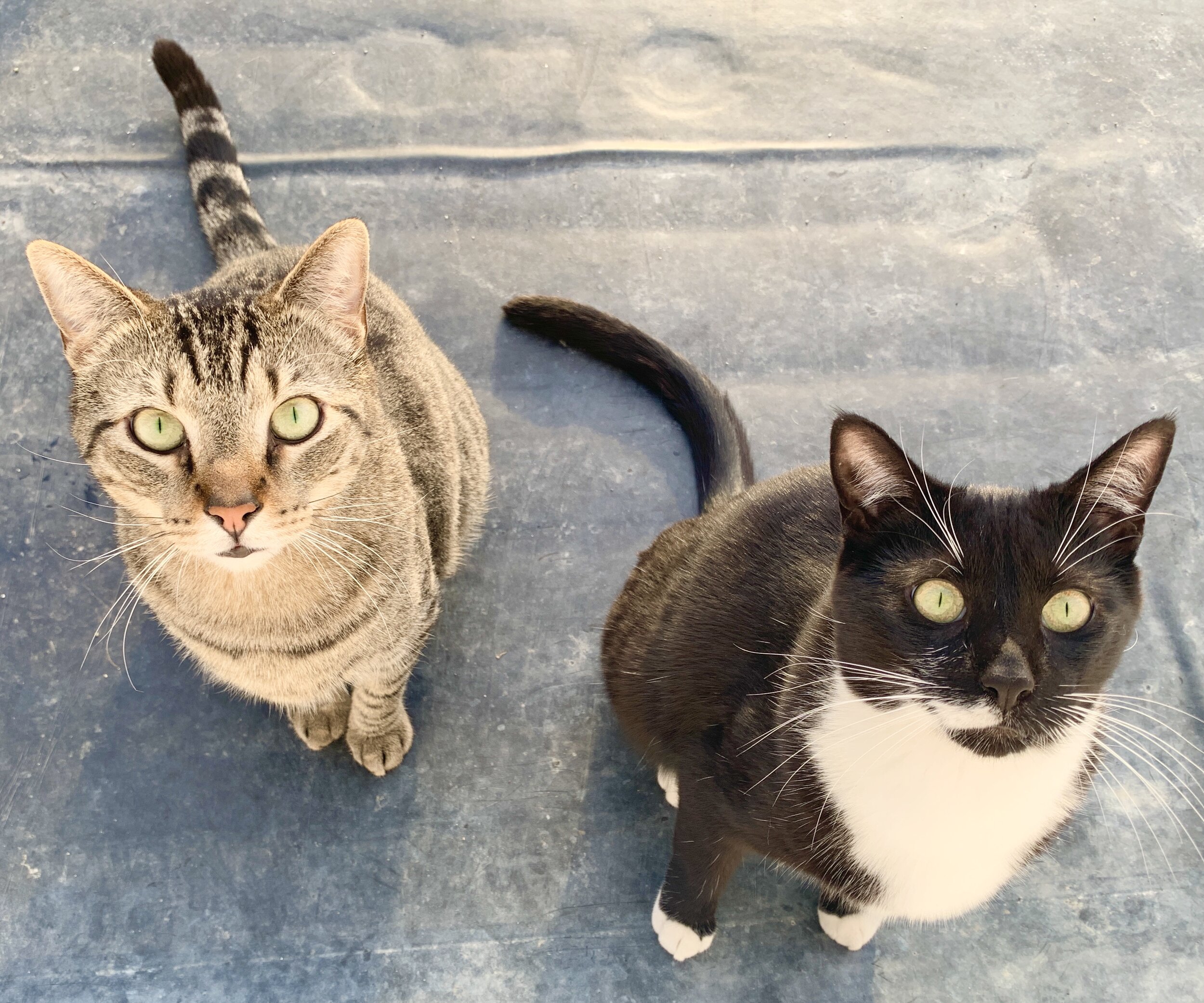Cat Adoption Process
and Information
We have a very high adoption success rate at Sweet Paws Rescue (SPR) because our process of matching kittens with their humans is effective. Whether you have fallen in love already, or looking for our matchmaking assistance, we are your partner throughout this adoption process.
THE APPROVAL PROCESS
If you would like to adopt, the first step is the submission of our online application. You may apply for a specific cat or kitten, or leave this information blank if you are not sure. Once submitted, you will be connected with an adoption coordinator to start the approval process. The time frame from application to approval typically ranges between 48 to 96 hours depending on your responsiveness along with your references.
Please do not submit an application until you are ready & committed to adopt from SPR. In addition to reviewing your application and providing you with a personalized process to match you with the right kitten, we talk to your references, including your veterinarian and landlord, if applicable.
THE ADOPTION
We do not operate as a traditional shelter that has animals in cages/kennels. We are 100% foster-based so all of our kitties are in a volunteer foster's home until they get adopted. This foster-based model means we are able to learn a lot about the personalities and temperaments of our cats and kittens. In our experience this enables us to have meaningful conversations with our adopters and facilitates excellent matches!
As an adopter, you are an extension of the rescue process. Many animals end up in shelters or back in rescue because their humans were not prepared for the commitment and responsibility of owning a pet. Before filling out an application, please evaluate your ability to care for a cat or kitten (financially and otherwise), for the span of its lifetime (sometimes up to 20 years!) Their life depends on it.
ADOPTION FEES
Our adoption fee is $325 for one kitten ($550 for two kittens) up to age 12 months, $200 for cats aged 1-8, $100 for cats 8+. If you are 65 or older, please ask us about our Seniors for Seniors adoption program! The adoption fee includes:
Age appropriate vaccinations (FVRCP: Feline Viral Rhinotracheitis/Calicivirus/Panleukopenia vaccine)
Rabies certificate and tag for kittens 16 weeks and older
Parasite prevention treatments
Spay or Neuter (If cat is not altered upon arrival, SPR will arrange an appointment at one of our participating Veterinarians at our expense)
Feline leukemia (FeLV) and feline immunodeficiency virus (FIV) SNAP testing
Microchip (to be inserted by your Veterinarian)
General wellness exam visits
Health certificate
1-month flea/tick topical preventative (completed at time of transport)
Transport to Massachusetts (if applicable)
48-hour quarantine in a MA USDA approved ISO facility
Wellness Check by our Veterinarian prior to being released from our ISO facility
In addition to providing the love, food, and basic veterinary care our animals need to thrive, we are also providing behavioral evaluations when necessary, any required medications, and sometimes even life sustaining surgeries and emergency care.
Our adoption fee does not cover our entire cost of vetting, additional medical care or medications, food, care, and supplies for each of our cats. We rely on fundraising to compensate for those deficits and cannot reduce this already discounted fee.
PAPERWORK
Your kitten will come with an adoption folder which includes its veterinary paperwork from the south, as well as the general wellness exam before release from our Massachusetts facility. This folder also contains your kittens’ microchip, to be inserted by your Veterinarian.
BRINGING YOUR KITTEN HOME
Bringing a new cat or kitten home can be a wonderful experience for you and your family. Your new furry friend will need your patience and understanding during this transition. It is important to remember that your new cat or kitten has been through many new experiences lately. Many of our cats come to us from the south, riding in a USDA approved transport truck. After their long journey, MA state law requires that they get a vet visit, receive a health certificate, and stay at our quarantine facility for 48 hours where their needs are attended to by our loving staff. From there they either go to their forever or foster homes. We are so happy they are transitioning to being home with you!
Preparing your home for your new cat or kitten
When you take your cat home, he may be frightened or unsure about what’s happening, so it’s important not to overwhelm him. Prepare a special area for the cat to help ease his adjustment into a new home environment. Sometimes it is better to confine the cat to a small room, such as a bathroom, at first, to let him adjust before giving him free rein in your home. Equip the room with food and water dishes and a litter box. Another reason that we recommend a small room is because cats will typically hide in new environments. It is not uncommon for a cat to hide underneath a bed or in a dark, quiet place for the first couple of days. Isolating your cat when you first take her home allows you to know what room she is in and helps you to monitor her eating, drinking and bathroom habits more closely.We request that all cats be housed indoors only. A garage, backyard or outdoor enclosure is not a suitable accommodation for a cat.
Supplies you will need for your new cat
At least one bowl for dry food and one for water: Stainless steel or ceramic work best.
A supply of dry cat food
A soft place to sleep
Litter box: Make sure the box is an appropriate size for the cat.
Litter
Scratching posts or trays: Try different types to see which the cat prefers.
Cat treats: Giving treats is a good way to help train and build a positive relationship with your foster cat.
Cat toys: Make sure the toys are durable and safe (without bits that will be harmful if swallowed).
Cat-proofing your home
Before bringing home a new cat, you’ll want to survey the area where you are going to keep the cat. Remove anything that would be unsafe or undesirable for the cat to chew on, and latch securely any cupboards that the foster cat could get into. Cats like to climb up on shelves or bookcases, so you’ll want to remove anything that can be knocked down. People food and chemicals can be very harmful if consumed by cats, so please store them in a place that the cat cannot access.
Never underestimate your cat’s abilities. Here are some additional tips for cat-proofing your home:
Make sure that all trash cans are covered or latched and keep them inside a closet. (Don’t forget the bathroom trash bins.)
Keep the toilet lids closed.
Keep both people and pet food out of reach and off all counter tops.
Move house plants out of reach. Many house plants are toxic to cats and they like to chew on them.
Make sure aquariums or cages that house small animals, like hamsters or fish, are securely out of reach of your foster cat.
Remove medications, lotions or cosmetics from any accessible surfaces.
Move and secure all electrical and phone wires out of reach. Cats may chew on or get tangled in them.
Pick up any clothing items that have buttons or strings, which can be harmful to your cat if consumed.
All cats adopted through Sweet Paws must live indoors. If your cat seems very curious about going outside or is constantly at the door waiting for the right moment, please take extra precautions to ensure that he or she doesn’t accidentally sneak out when you are coming or going.
Cat introductions
If you have personal pets who are cats, you’ll need to introduce them to your new cat. Even if know the cat you are adopting is good with other cats, you’ll want to do the introductions gradually. So, before bringing your new cat home, create a separate “territory” for her. This area should be equipped with food, water, a scratching post, a litter box, access to natural sunlight, and comfortable resting places. Your other cats should have their own separate territory.
Over a one- to two-week period, let the cats smell each other through a closed door, but don’t allow them contact with one another. Exchanging blankets or towels between the areas will help them get used to each other’s smells. The next step is to allow them to see each other through a baby gate or a door that is propped open two inches. If the cats are interested in each other and seem comfortable, allow them to meet. Open the door to the rooms between the cats and observe them closely. If any cat shows signs of significant stress or aggression, separate them again and introduce them more slowly.It’s a good idea to have a broom or squirt bottle on hand to deter any fights. Never try to separate cats who are fighting with your hands or body parts.
Dog introductions
If you have a personal pet who’s a dog, you’ll need to make the introduction to the new cat carefully and safely. Start by keeping them separated at first. As mentioned above, before you bring your cat home, create a separate “territory” for her and equip it with food, water, a scratching post, a litter box, and comfortable resting places.
Over a one- to two-week period, let the dog and cat smell each other through the door, but don’t allow them contact with one another. Exchanging blankets or towels between the dog’s area and the cat’s area will help them get used to each other’s smells.
After a week or two, do the face-to-face introduction. Keeping your dog on leash, allow your foster cat out in the same area. (If you have more than one dog, introduce one at a time.) Do not allow the dog to charge or run directly up to the cat. Try to distract the dog as best you can so that the cat has the chance to approach without fear. Watch the body language of each animal closely and don’t continue the interaction if either pet becomes over-stimulated or aggressive. The idea is to keep the interactions positive, safe and controlled.
Children and cats
Since we don’t always know a cat’s history or tolerance level for different types of people and activities, please teach your children how to act responsibly and respectfully around your new cat. We will do our best to place you with an appropriate animal for your home situation, but you should still supervise all interactions between children and your cat. Key things to remind your children:
Always leave the cat alone when he/she is eating or sleeping. Some cats may nip or bite if bothered while eating or startled while sleeping.
Do not tease or rile up the cat.
Don’t chase the cat around the house; it may scare him.
Pick up the cat only when an adult is there to help. Cats can become scared when picked up, and they sometimes scratch with their sharp nails, even though they don’t mean to cause harm.
Be careful when opening and closing doors so as to not accidentally let the cat outside.
Changing Diet
While at our isolation facility your cat or kitten has been eating high quality food (ask your adoption coordinator for more details), but this is the best time to change to whatever you plan on feeding them. When changing to a different food, it’s important to mix the old food in with the new food, and switch over slowly to avoid stomach upset. Start by mixing 3/4 old food with 1/4 new food, then 1/2 old food 1/2 new food, then 1/4 old food, 3/4 new food until you are switched over to the new food completely.
Establishing a Relationship with your Veterinarian
It is important for both you and your new family member to establish a relationship with his or her veterinarian. Even though your cat has had a check up with our veterinarian on arrival, we ask that you have them seen by your own vet within 7 DAYS of taking them home. Some of the kittens and adult dogs may need time sensitive booster shots to be fully vaccinated.
Sweet Paws Rescue would like to thank Best Friends Animal Society for their guidance in creating this manual.


